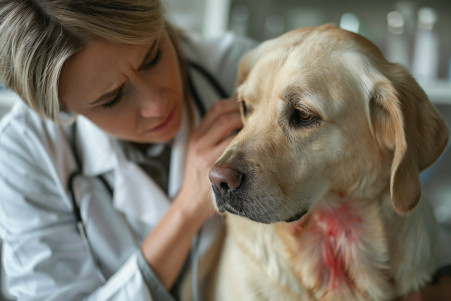Do Dogs Get STDs? What to Know About Canine Sexual Health
13 March 2024 • Updated 13 March 2024

When we think about our pets’ health, we often think about their shots and regular check-ups, but there’s another side to pet health that we need to consider: sexually transmitted diseases (STDs). That’s right, dogs can get STDs, including Canine Brucellosis, Canine Herpes Virus, and Canine Transmissible Venereal Tumor (CTVT).
Dogs can contract these diseases through sexual contact, contact with bodily fluids, and even through non-sexual contact, and they require veterinary care for diagnosis and treatment.
Taking a closer look at the world of dog health and diseases, this article will examine research from veterinary science, epidemiology, and public health. Scholars will discuss what we know about sexually transmitted diseases in dogs, including how they work, how they’re transmitted, and how they’re treated.
As well as how these diseases can be prevented and what that means for pet and public health. This information will help pet parents better protect their furry friends.
Do dogs get STDs?
Understanding Canine Brucellosis
The bacterium Brucella canis causes Canine Brucellosis, a highly contagious disease in dogs. It is best known for its impact on dogs’ reproductive systems, causing infertility and other reproductive problems. According to the Merck Veterinary Manual, Canine Brucellosis is highly contagious in kennels and breeding facilities, and it is transmitted through breeding, ingestion of contaminated materials, and contact with infected fluids, such as vaginal discharges and semen.
In dogs, symptoms include late-term miscarriages in females and a long-lasting vaginal discharge after a miscarriage. Males can experience inflammation of the reproductive organs, which can lead to a decreased desire to mate or impotence. The Minnesota Department of Health notes that dogs can also experience swollen lymph nodes, eye problems, and spinal infections, and they often appear healthy except for their reproductive issues.
A review on PMC explains that Canine Brucellosis is usually diagnosed by veterinarians using serologic tests to detect antibodies against Brucella canis. The Rapid Slide Agglutination Test (RSAT) and the Polymerase Chain Reaction (PCR) are used to confirm the diagnosis. Canine Brucellosis is difficult to treat, and veterinarians typically prescribe long-term antibiotics and recommend spaying and neutering to prevent the disease from spreading.
The zoonotic potential of Canine Brucellosis complicates matters because humans can contract the disease through close contact with infected animals or their secretions. Public health officials stress the importance of good hygiene and regular testing for breeders and veterinarians, who are at the highest risk of contracting the disease.
While human Brucellosis is usually caused by other Brucella species, B. canis can still cause human disease, so it’s important to be aware of the risks and take preventive measures.
What Are the Dangers of Canine Transmissible Venereal Tumor?
Canine Transmissible Venereal Tumor (CTVT) is a type of cancer that only affects dogs. It is one of only three known transmissible cancers and is most commonly spread through sexual contact or direct contact with the affected tissue. According to the Merck Veterinary Manual, CTVT tumors are most commonly found on the external genitalia but can also occur on other mucosal sites, such as the mouth or nose, through contact with the lesions.
The clinical presentation of CTVT can vary from small nodules to large masses. The growths are typically ulcerated and can be friable, meaning they can bleed easily. If the growths are not properly diagnosed, they can be mistaken for other causes of bleeding. A study published in PMC found that veterinarians have the most success treating CTVT with chemotherapy, especially vincristine sulfate, which has a high remission rate.
CTVT has been reported in over 90 countries around the world and is most common in tropical and subtropical regions. According to ScienceDirect Topics, the disease is rare in North America and central Europe, but is endemic in many underdeveloped regions, making it a significant challenge to animal health.
The fact that CTVT is so widespread shows the importance of dog owners being aware of their pets’ health, especially if they are considering breeding or allowing their pets to interact with other dogs.
Stopping the Spread of STDs in Dogs
Stopping the spread of STDs in dogs is important for the health of individual animals and the welfare of dog populations as a whole. Responsible breeding is key to stopping the spread of diseases like Brucellosis and Canine Herpes Virus. Testing for Brucellosis before breeding is important, and dogs that test positive should not be bred, according to Dutch.
Spaying and neutering are also important in the control of STDs in dogs. In addition to preventing unwanted litters, spaying and neutering also limit the spread of STDs through sexual contact. Regular veterinary care and specialized testing for sexually active dogs can help ensure that STDs are caught and managed early, allowing for timely and appropriate interventions by veterinarians.
Public awareness and education about STDs in dogs are important to promote responsible pet ownership. Accessing educational materials, such as dog care and health blogs, can help dog owners learn how to prevent these diseases. By continuing to make the health of our dogs a priority and taking these steps, we can help ensure that our dogs are healthier and that the public is better informed.
Protecting Canine and Human Health: The Role of Veterinary Public Health
Veterinary Public Health (VPH) professionals are responsible for the oversight of sexually transmitted diseases (STDs) in dogs, a role that goes far beyond the welfare of pets to protect human health. The FAO notes that VPH includes activities that prevent, control, and eliminate animal-origin diseases, including canine STDs, which can be zoonotic and therefore affect humans.
VPH is most effective when it is interdisciplinary, involving the collaboration of veterinarians, public health professionals, and other scientists.
A paper from PMC notes that there is a desperate need for the creation of systems and protocols to monitor and control STDs in dogs. Veterinary professionals are responsible for the implementation of infection control programs that are designed to limit the spread of diseases in veterinary hospitals and the community at large, including the risks associated with direct and indirect contact, and to protect both animal and human health.
The CDC explains that international collaboration and the willingness of countries to follow guidelines are essential to the control of zoonoses, which are diseases that can be transmitted from animals to humans. The sharing of information and approaches on a global scale is important for ensuring that there are consistent protocols for the control and prevention of diseases.
Still, there are many obstacles in developing countries, where VPH services are often scarce. The FAO suggests that a targeted approach is needed to improve VPH systems, surveillance, and international collaboration. The goal is that with these combined efforts, the global community will be able to control STDs in dogs and protect the health of all species.
A Note on STDs in Dogs
As we’ve navigated the complex world of dog health, we’ve learned that dogs, like people, can contract STDs like Canine Brucellosis and Canine Transmissible Venereal Tumor (CTVT). These STDs underscore the importance of understanding how these diseases are spread, which in these cases can include breeding and exposure to bodily fluids, and the need for effective treatment.
Prevention and control are key to keeping dogs safe from STDs. Through responsible breeding, regular veterinary care, and the promotion of spaying and neutering, we have the tools we need to protect our dogs. Pet owners, veterinarians, and public health officials all have a role to play in the management and prevention of these diseases.
The importance of awareness and education can’t be overstated. By continuing to encourage informed pet ownership and preventive care, we can work toward a future where STDs in dogs aren’t hidden dangers but manageable conditions. Let’s work together to create a world where every tail wag and happy bark is a sign of health for our furry friends.


